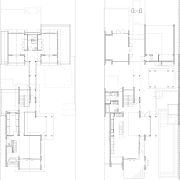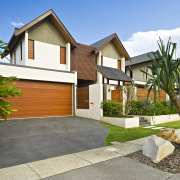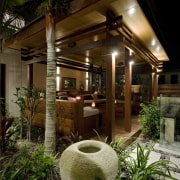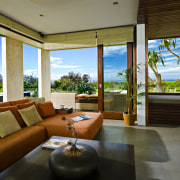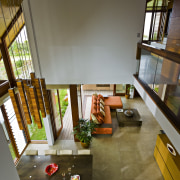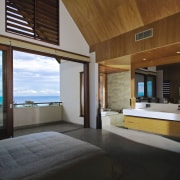Cocktails poolside
With its open-air walkways and pavilion-style architecture, this house takes its cue from modern Balinese resorts
Tropical resort holidays are memorable for lots of reasons, including the balmy climate, swaying coconut palms and the laid-back luxury that is part of the deal at a five-star resort hotel.
It's a lifestyle the original owner of this house is familiar with he was the developer of the Bale resort in northern Queensland. So it was hardly surprising he contracted the same architectural team to design his new house along similar lines.
Perth-based Grounds Kent Architects (GKA) is renowned for its resort portfolio the firm has designed hotels in Bali, (including the Four Seasons), the Maldives and Barbados. Architect Scott Bradley says the house was designed to reflect the spirit of these resorts, but it also had to respect the northern New South Wales coastal location, which is somewhat cooler and windier than most tropical locations.
"We still played with the idea of open-air walkways and pavilion-style architecture," he says. "The entrance, for example, presents a courtyard in the Balinese tradition, rather than a typical front yard. The stepping stones, pebbles and water feature are all reminiscent of this architectural style."
The architect also introduced Japanese-style chains rather than downpipes for the water run-off at the front of the house. These bring the water from the roof to the reflection pool and a garden, which incorporates hidden drainage.
The extensive use of kwila timber and imported merbau joinery from Bali further reinforces the resort ambience. At the front of the house, kwila battens on the upper facade fold down and under to form the ceiling of the breezeway and covered walkway. This ceiling follows the central axis, extending into the dining room where it stops at the edge of a double-height void.
"The slatted timber element helps to blur the line between inside and out, enhancing the sense of a tropical pavilion," says Bradley. "For visual continuity, we repeated the ceiling, which is almost like an upside-down deck, above the kitchen."
The central axis, including the breezeway, leads through a series of courtyards on each side of the house, which provides cross ventilation. In addition, the main living area opens up to the pool much like a traditional Balinese pavilion.
"The corner of this room is free of columns, so the full-height glazed doors can be opened to provide a living space that is virtually an outdoor room," says Bradley. "This space leads onto a floating deck that appears to hover above the ground. As there are no balustrades, the deck is quite dramatic and there is nothing obstructing the view of the ocean."
The architect also played with differing levels around the pool to minimise the need for pool fencing. A lowered ground level means the pool wall is the required height for safety purposes, yet the water and the infinity edge is still at eye level when viewed from inside. There is also a stand-alone outdoor entertaining pavilion, with the seating on a level with the top of the pool.

To maintain the laid-back tropical feel, the kitchen is designed to be as unobtrusive as possible. Key appliances and the sink bench are concealed behind doors, and the island work top is partially hidden behind a raised bar top.
Bradley says the island, which features horizontal walnut wood grain and a large negative detail, is more like a discreet, minimalist piece of furniture.
The master suite, on the first floor, continues the tropical theme. A luxurious tub sits in an alcove that is wrapped in kwila battens the timber lines the ceiling and the walls. Large wooden shutters open to reveal the spectacular ocean view.
"The slatted kwila lining makes bathing more of an outdoor experience," says Bradley. "It defines the space as a different zone a place to escape, much like a true resort."
Story by: Colleen Hawkes
Home kitchen bathroom commercial design
Classic looks, contemporary efficiency
Diving into nature
Personality plus

